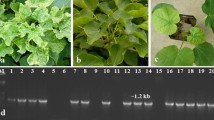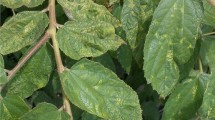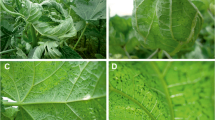Abstract
The virus causing horsegram (Macrotyloma uniflorum) yellow mosaic disease has been shown to be a typical Old World bipartite begomovirus. The viral origin of the disease has been established through agroinoculation of horsegram using partial tandem repeat clones of both DNA-A and DNA-B. The DNA-A genome shows less than 89% identity with the corresponding sequences of all the begomoviruses in the databases earlier to this sequence submission (AJ627904). Therefore Horsegram yellow mosaic virus (HgYMV-[IN:Coi]) can be considered to be a new species of the genus Begomovirus (family Geminiviridae). Phylogenetic analysis shows that this virus is part of the cluster of mungbean yellow mosaic viruses of legumes from South and South East Asia.






Similar content being viewed by others
References
Barnabas, A. D. (2007). Molecular characterization of Horsegram yellow mosaic virus and efforts towards the development of transgenic soybean expressing truncated replicase gene of Soybean yellow mosaic virus. PhD thesis submitted to Madurai Kamaraj University.
Bevan, M. (1984). Binary Agrobacterium vectors for plant transformation. Nucleic Acid Research, 12, 8711–8721.
Cha, J., Bishai, W., & Chandrasegaran, S. (1993). New vectors for direct cloning of PCR products. Gene, 136, 369–370.
Ditta, G., Stanfield, S., Corbin, D., & Helinski, D. R. (1980). Broad host range cloning system for Gram-negative bacteria: construction of a gene bank of Rhizobium meliloti. Proceedings of National Acadamy of Sciences, 77, 7347–7351.
Fauquet, C. M., Bisaro, D. M., Briddon, R. W., Brown, J. K., Harrison, B. D., Rybicki, E. P., et al. (2003). Revision of taxonomic criteria for species demarcation in the family Geminiviridae and an updated list of begomovirus species. Archives of Virology, 148, 405–421.
Fauquet, C. M., Briddon, R. W., Brown, J. K., Moriones, E., Stanley, J., Zerbini, M., et al. (2008). Geminivirus strain demarcation and nomenclature. Archives of Virology, 153, 783–821.
Fontes, E. P. B., Gladfelter, H. J., Schaffer, R. L., Petty, I. T. D., & Hanley-Bowdoin, L. (1994). Geminivirus replications have a modular organization. The Plant Cell, 6, 405–416.
Girish, K. R. & Usha, R. (2005). Molecular characterization of two soybean-infecting begomovirus from South-East Asia. Virus Research, 108, 167–176.
Government of T. N. (2006). Department of Economics and Statistics, Seasons and Crop Report 2005–2006. Retrieved September 09.2009, from http://www.tn.gov.in/crop/AreaProduction.htm.
Hall, T. (2005). http://www.mbio.ncsu.edu/RNaseP/info/programs/BIOEDIT/bioedit.html.
Hood, E. E., Gelvin, S. B., Melchers, L. S., & Hoekema, A. (1993). New Agrobacterium helper plasmid for gene transfer to plants. Transgenic Research, 2, 208–218.
Jayan, P. K. & Maya, C. N. (2001). Studies on the germplasm collection of Horsegram (Macrotyloma uniflorum (Lam.) Verdc.). Indian Journal of Plant Genetic Resources, 14, 43–47.
Lazarowitz, S. G., Wu, L. C., Rogers, S. G., & Elmer, J. S. (1992). Sequence specific interaction with the viral AL1 protein identifies a geminivirus DNA replication origin. The Plant Cell, 4, 799–809.
Muniyappa, V., Reddy, H. R., & Shivashankar, G. (1976). Studies on the yellow mosaic disease of horsegram (Dolichos biflorus Linn.). II.Host range studies. Mysore. Journal of Agricultural Science, 10, 610–614.
Muniyappa, V., Reddy, H. R., & Mustak Ali, T. M. (1978). Studies on the Yellow Mosaic disease of horsegram (Dolichos biflorus), IV.Epidemeology of disease. Mysore Journal of Agricultural Science, 12, 277–279.
Muniyappa, V., Rajeshweri, R., Bharathan, N., Reddy, D. V. R., & Nolt, B. L. (1987). Isolation and characterization of a geminivirus causing yellow mosaic disease of Horsegram (Macrotyloma uniflorum(Lam.)Verdc.) in India. Indian. Journal of Phytopathology, 119, 81–87.
Perrière, G. & Gouy, M. (1996). WWW-Query: an on-line retrieval system for biological sequence banks. Biochimie, 78, 364–369.
Porebski, S., Bailey, L. G., & Baum, B. (1997). Modification of a CTAB DNA extraction protocol for plants containing high polysaccharide and polyphenol components. Plant Molecular Biology Reporter, 15, 8–15.
Qazi, J., Ilyas, M., Mansoor, S., & Briddon, R. W. (2007). Legume yellow mosaic viruses: genetically isolated begomoviruses. Molecular Plant Pathology, 8, 343–348.
Sharma, K. R. (1995). Nature of variation and association among grain yield and yield components in horsegram. Crop improvement, 22, 73–76.
Stanley, J. (1995). Analysis of African cassava mosaic virus recombinants suggests strand nicking occurs within the conserved nonanucleotide motif during the initiation of rolling circle DNA replication. Virology, 206, 707–12.
Swanson, M. M., Varma, A., Muniyappa, V., & Harrison, B. D. (1992). Comparative epitope profiles of the particle proteins of whitefly-transmitted geminiviruses from nine crop legumes in India. Annals of applied Biology, 120, 425–433.
Thompson, J. D., Gibson, T. J., Plewniak, F., Jeanmougin, F., & Higgins, D. G. (1997). The ClustalX windows interface: flexible strategies for multiple sequence alignment aided by quality analysis tools. Nucleic Acid Research, 24, 4876–4882.
William, F. J., Grewal, J. S., & Amin, K. S. (1968). Serious and new disease of pulse crops in India in 1966. Plant Disease Reporter, 52, 300–304.
Acknowledgements
We acknowledge funding from Department of Biotechnology, Government of India. ADB thanks University Grants Commission for FIP fellowship and GKR thanks Council of Scientific and Industrial Research for SRF. We are grateful to Tamil Nadu Agricultural University for the horsegram samples and Dr. V. G. Malathi for EHA105. We thank School of Biotechnology, Madurai Kamaraj University for the facilities.
Author information
Authors and Affiliations
Corresponding author
Rights and permissions
About this article
Cite this article
Barnabas, A.D., Radhakrishnan, G.K. & Ramakrishnan, U. Characterization of a begomovirus causing horsegram yellow mosaic disease in India. Eur J Plant Pathol 127, 41–51 (2010). https://doi.org/10.1007/s10658-009-9569-1
Received:
Accepted:
Published:
Issue Date:
DOI: https://doi.org/10.1007/s10658-009-9569-1




